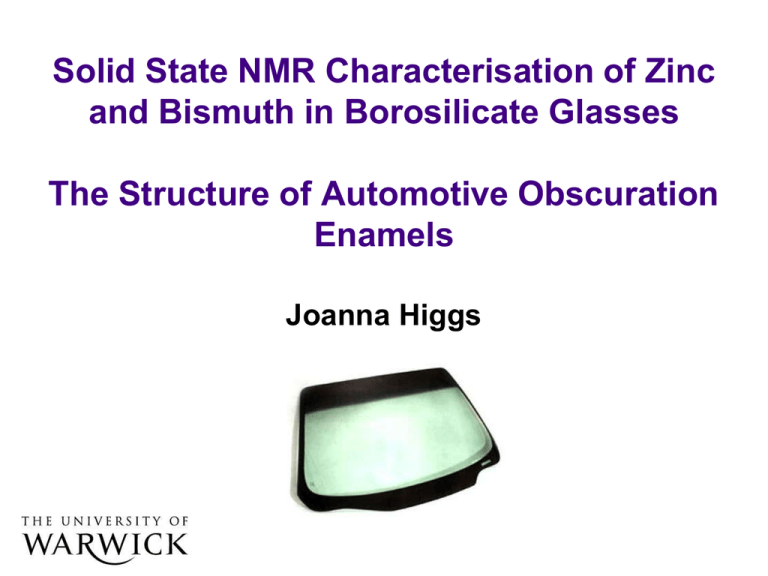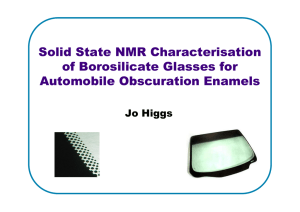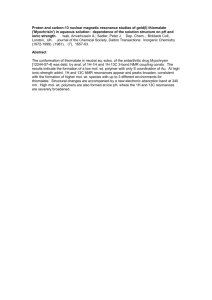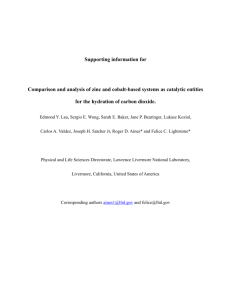Solid State NMR Characterisation of Zinc and Bismuth in Borosilicate Glasses
advertisement

Solid State NMR Characterisation of Zinc and Bismuth in Borosilicate Glasses The Structure of Automotive Obscuration Enamels Joanna Higgs Contents • Background – Automotive Enamels – Structure of Glasses – NMR • Model Glasses – Aim – NMR results – Further Work 2 Background Automotive Obscuration Enamels Functions – – – – shield glue from UV light hide silver connections control of crystallisation to aid manufacturing aesthetic design New Product – must pass strict industry acid tests – low firing temp. < 600 C – control of thermal expansion 3 Background Glass Structure • Amorphous solid without long range periodic atomic arrangement. • Structural units – depend on the composition – affect the physical properties. • Formed of oxides – network formers e.g. SiO2 and B2O3 – network modifiers e.g. Na2O – Intermediates Si O Sodium silicate Na 4 Borosilicate Glasses • Zinc and bismuth added for physical properties – NMR literature: alkali borosilicates without these additions • Effects of zinc and bismuth on the structure • Commercial samples: no compositional trends • Zinc and bismuth substitute boron in the compositions – do they also substitute it in the glass network? 5 Solid State NMR • NMR: local structure • Magic Angle Spinning: 54.74 → narrow spectra – Using 4 → 30 kHz • NMR Isotropic Chemical Shift δ • NMR on Quadrupolar nuclei: I > 1/2 – Looking at 11B and 23Na: spin 3/2 – Also 29Si: spin 1/2 6 Borosilicate Glasses Compositions: NMR Experiments: • Base Glass Basic: single pulse 11B, 23Na, 29Si 63% Si, 16% Na, 21% B • B + Zn or Bi = 21 mol% To improve resolution: • Si + Na ~ constant for all samples • 11B • 11B • Some contain more Zn and Bi than commercial glasses Multiple Quantum Magic Angle Spinning (MQMAS) Double Rotation (DOR) 7 11B NMR 11.7 T 7.1 T 10 kHz 10 kHz B4 B4 3.2 mol% ZnO B3 B3 15.2 mol% Bi2O3 8 11B NMR Zinc Bismuth 75 75 11.75 T 7.05 T B4 Relative Abundance / % 70 65 65 60 60 55 55 50 50 45 45 40 40 35 0 5 10 mol% ZnO 15 11.7 T 7.05 T 70 20 35 0 5 10 15 20 mol% Bi2O3 9 11B – MQMAS Multiple Quantum Magic Angle Spinning Base glass 14.1 T 13.9 kHz 1D MAS spectrum ppm t1 t1 π/2 π/2 t2 * 0 Projection B4 20 +3 +2 +1 p= 0 -1 -2 -3 40 60 * B3 80 100 30 20 10 0 ppm *spinning sideband 10 11B – DOR • More quantitive and sensitive than MQMAS • Difficult to spin • Eliminates line broadening 11.7 T Base glass 3 B4 Sites 9.4% Bi 3 B4 Sites 2 B3 Sites 2 B3 Sites * * * denote spinning sidebands * * * * 11 23Na Lines fitted in black NMR 3.2 % Zinc 14.1 T 7.1 T 10 kHz iso (ppm) 6 20 kHz Zinc 4 4 2 2 0 0 -2 -2 -4 -4 -6 -6 14.1 T 9.4 T 7.05 T -8 5 10 15 20 mol% ZnO 25 30 14.1 T 9.4 T 7.05 T -8 -10 0 Bismuth 6 35 -10 0 5 10 15 20 25 30 35 mol% Bi 2O3 Increase in electron density → network becomes less connected 12 29Si NMR (a) (b) 3.2 mol% ZnO 3.4 mol% Bi2O3 7.1 T 3.5 kHz -60 -70 -80 -90 -100 -110 -120 -130 -140 ppm -60 Weighted Average Chemical Shift (ppm) -84 -86 -70 -80 -90 -100 -110 -120 -130 -140 ppm -84 -86 Zinc -88 -88 -90 -90 -92 -92 -94 -94 -96 -96 -98 -98 -100 -100 Bismuth -102 -102 0 5 10 15 20 mol% ZnO 25 30 35 0 5 10 15 20 25 30 35 mol% Bi 2O3 Nuclei less shielded → less bridging oxygens → less connected 13 Conclusions • Roles of zinc and bismuth: – Bi and Zn not replacing B in the network – Network is less connected with higher Bi / Zn content – Bi and Zn acting as network modifiers • Zinc and bismuth not acting identically • Further work: zinc and bismuth together 14 Zinc-Bismuth Glasses 4.5 Density g/cm3 ZB1 ZB2 ZB3 ZB4 ZB5 Mol% SiO₂ B₂O₃ Na₂O Bi₂O₃ ZnO 64.1 6.1 14.3 15.2 0 64.6 5.6 14.5 11.4 3.8 64.2 5.7 14.7 7.7 7.7 64.1 5.9 14.5 3.9 11.5 62.8 5.9 15.3 0 15.9 4 3.5 3 2.5 0 5 Mol% ZnO 10 15 66 64 11B Relative Abundance B4 / % 62 11.7 T 60 58 56 54 52 50 48 46 30 25 20 15 10 5 0 -5 -10 -15 -20 ppm 0 2 4 6 8 Mol% Bi2O3 10 12 14 16 15 Acknowledgments • Industrial Supervisors – Peter Bishop, Jon Booth, Hong Zheng • University of Warwick Supervisors – Mark E. Smith, John V. Hanna • Warwick NMR Group – Nathan Barrow, Andy Howes • Funding from EPSRC Thank you for listening 16






